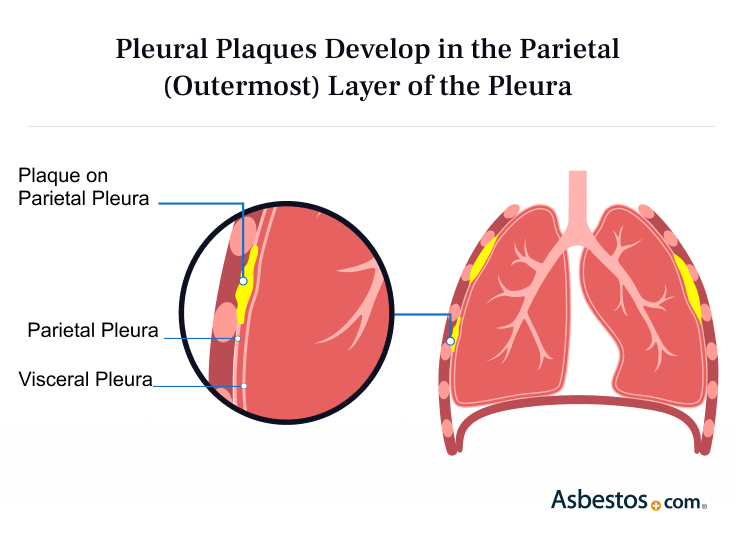Jack Riordan was diagnosed 30 years ago with pleural plaques, an asbestos-related condition. When shortness of breath became an issue, he knew it might be severe. He had spent much of his career working with asbestos insulation, doing asbestos abatement and general contracting. He said of his mesothelioma diagnosis, “I knew this was a possibility a long time before.”
Pleural Plaques and Asbestos
Pleural plaques are the most common sign of asbestos exposure. They are benign areas of thickened tissue in the lung lining's outer layer. Pleural plaques don't cause mesothelioma or other asbestos-related diseases. But they can signal a greater risk of disease.
What Are Pleural Plaques?
Pleural plaques are thickened tissue that forms as a reaction of asbestos fibers becoming lodged in the pleura. Pleural plaques develop on the outermost layer of the pleura and are noncancerous.
- Pleural plaques are not malignant. But they are a diagnostic factor for pleural mesothelioma.
- CT scans can detect pleural plaques with 95% to 100% accuracy.
- Pleural plaques are usually 2 mm to 5 mm thick and form 20-30 years after exposure to asbestos.
Most people with pleural plaques don’t exhibit symptoms and can live years without health problems. Some patients do report pain or a grating sensation while breathing.
Another term for pleural plaques is hyaline pleural plaques. They contain hyaline tissues found in cartilage. Pleural plaques, which are caused by prolonged asbestos exposure, can raise the risk of pleural mesothelioma or asbestos-related lung cancer. Imaging tests help identify pleural plaques.

What Are Calcified Pleural Plaques?
Pleural plaques become calcified when calcium salts build up in the tissue. The calcium salts harden the plaques much like the substances that harden bones. Calcified pleural plaques are seen in 10% to 15% of cases, according to the medical text “The Teaching Files: Chest.”
Noncalcified plaques are pliable and rubbery. But, over time, they can calcify from long asbestos exposure. Calcified pleural plaques can also be a precursor of asbestosis and pleural mesothelioma.
How Are Pleural Plaques Caused?
Pleural plaques are mainly caused by asbestos exposure. An immune response of pleural macrophages can also cause them. They may appear 20-30 years after exposure to asbestos.
The thick pleural tissue in pleural plaques does not always lead to mesothelioma. But a 2022 study in the journal Chest found that bilateral pleural plaques, nodules, and pleural effusions are diagnostic factors of mesothelioma.
The Role of Asbestos Fibers
Inhaled asbestos fibers can build up in the lung lining. The asbestos fibers irritate lung tissue and cause pleural plaques. Studies show asbestos fibers reach the pleural space via the lymphatic system.
Asbestos Exposure Sources
Sources of asbestos that can lead to pleural plaques include jobs with prolonged exposure to high levels of asbestos, including military service. Jobs where people handled asbestos products, such as on construction sites, are other sources. Some environmental exposures can lead to pleural plaques. These include living near an asbestos mine or an asbestos factory.
Pleural mesothelioma survivor Jack Riordan spent most of his career working with asbestos insulation. He was diagnosed with pleural plaques 30 years before doctors told him he had mesothelioma. “If I had worked in a grocery store all my life, it would have been devastating to hear,” Riordan said. “I was prepared.”
Verified Asbestos.com Survivor
Find a Doctor Today“You want a specialist who knows what they’re dealing with. That’s how I picked my doctor, and my patient advocate helped me with that.”
What Are the Symptoms of Pleural Plaques?
Most people with pleural plaques have no symptoms. Some may have chest pain or breathing problems. Symptoms appear from issues linked to asbestos exposure and the damage asbestos does to the respiratory system.
- Coughing up blood
- Chronic coughing
- Trouble breathing
While pleural plaques are not as aggressive as mesothelioma, their presence can indicate significant asbestos exposure. Imaging scans for possible respiratory symptoms may return a diagnosis of pleural plaques or pleural thickening.
How Are Pleural Plaques Diagnosed?
Pleural plaques are diagnosed with imaging scans such as X-rays and CT scans. Each type of imaging scan uses different techniques to show the presence of pleural plaques.
- CT Scans: A CT scan is the most accurate test for diagnosing pleural plaques. It is 95% to 100% correct. The test can reveal plaques anywhere in the chest, even if they are not calcified.
- X-rays: Radiologists find most pleural plaques after an X-ray. This test reveals areas with thickened nodular edges resembling a holly leaf or translucent white deposits on the lungs. In specific locations, these plaques can be difficult to identify via X-ray.
These imaging scans can also detect pleural mesothelioma. Doctors often find mesothelioma or other asbestos-related diseases when they are scanning patients for other conditions presenting similar symptoms.
Treatment and Management of Pleural Plaques
Pleural plaques do not need immediate treatment unless the condition is impacting lung function. Another reason pleural plaques are not treated is that the affected areas do not spread like mesothelioma tumors caused by asbestos exposure.
People with pleural plaques can maintain their lungs healthy and strong by taking on lifestyle changes. Check with your doctor first, but these lifestyle changes may help.
- Create and follow a healthy diet plan
- Quit smoking
- Taking on a routine exercise regimen
You can ask your doctor about lung function tests. These could pave the way for how you manage your lifestyle changes.
Common Questions About Pleural Plaques
- Are pleural plaques related to cancer?
-
Pleural plaques are not a form of cancer, although pleural plaques and fibrous thickening may increase your risk of pleural mesothelioma and lung cancer.
- Do pleural plaques increase the risk of developing lung cancer?
-
Yes, pleural plaques can raise the risk of developing asbestos lung cancer. This is because pleural plaques are an indication of prolonged asbestos exposure, which can cause lung cancer.
- What’s the difference between pleural plaques and pleural thickening?
-
Pleural plaques generally form in a small and localized locations. They are noncancerous. Pleural thickening, also noncancerous, is more widespread and more closely associated with a potential pleural mesothelioma diagnosis. Both are linked to asbestos exposure.
- Can pleural plaques lead to other lung conditions?
-
No, but they can raise the risk of more dangerous asbestos-related conditions like mesothelioma, asbestosis and asbestos-lung cancer.





